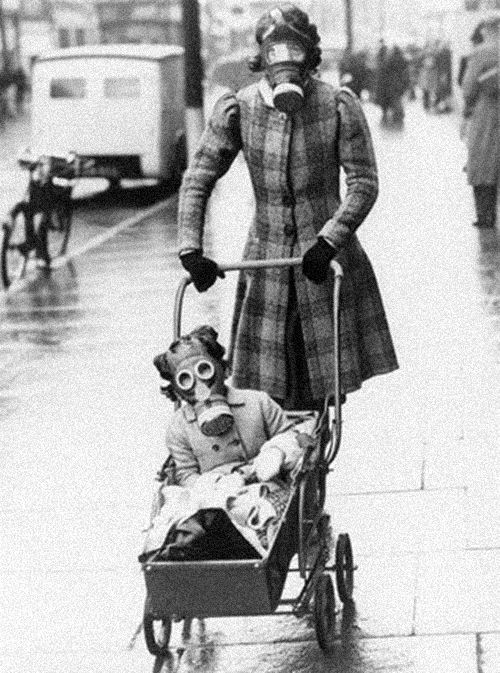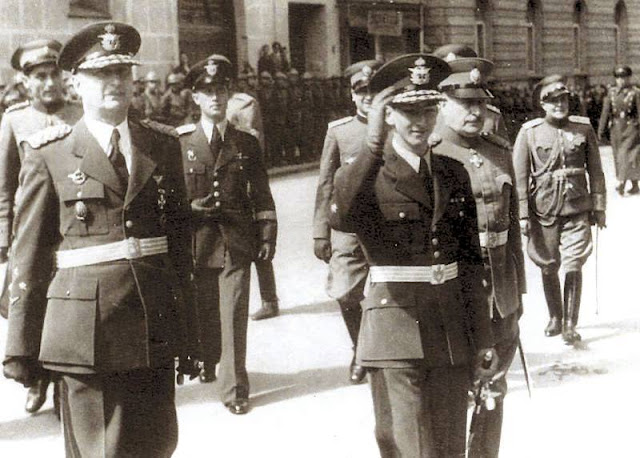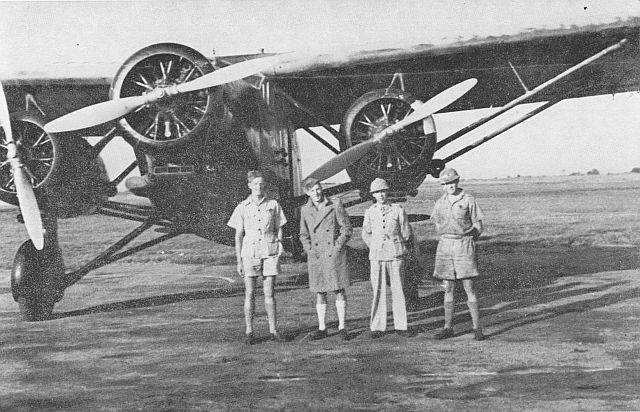Monday 31 March 1941
 |
| Loading a Cookie bomb on a Wellington for the raid on Emden, 31 March 1941. |
Germany and Yugoslavia sever diplomatic relations following the pro-British coup of 27 March.
British CIGS General John Dill is in Belgrade for discussions of joint defense with the Yugoslav government.
East African Campaign: The Italians and Germans know that the end is near for Massawa due to the collapse of the defenses at Keren. After dark, three (Leone, Pantera, and Tigre) of the last six destroyers there put to sea. Their intent is to raid the Gulf of Suez and then scuttle themselves. However, one of the destroyers, Leone, runs aground in the dark shortly after dark, canceling the operation. Since the destroyer cannot be recovered quickly, the other two destroyers sink the Leone, then return to Massawa.
The Indian 9th Infantry Brigade takes Teclesan. This is on the road to Asmara.
 |
| The Cookie bomb (upper left) falling on Emden, 31 March 1941. |
RAF Bomber Command also attacks shipping off Le Havre, continuing its focus on Axis shipping. Another group of RAF aircraft attack shipping off the Frisian Islands. Bremen also receives attention.
The Luftwaffe sends 47 bombers to attack Hull, dropping 39 tons of high explosives and 22,688 incendiaries. The docks are hit, along with the police station and an infirmary. Estimates are that the raid destroys 500 houses and damages 2000 more. There are 44 deaths and 72 badly wounded.
The early part of the month featured several sharp raids on England. There are 4259 civilian deaths and 5557 injured. Many children have returned to the cities after a quiet period earlier in the year, and 598 of them perish during March.
 |
| Dropping a Cookie bomb. |
U-46 (Kptlt. Engelbert Endrass) torpedoes and sinks 8714-ton Swedish tanker Castor southeast of Greenland. The Castor is a lejdtrafiken, or blockade runner. There are 15 deaths.
 |
| Swedish motor tanker Castor, sunk on 31 March 1941 in the North Atlantic. |
The Luftwaffe bombs and damages 182-ton British trawler Rattray a couple of miles southeast of Hook Point, County Wexford, Ireland. The Rattray makes it to port.
Royal Navy 247-ton minesweeping trawler HMT Lord Selborne hits a mine and sinks a few miles off Spurn Head Port War Signal Station. There are 17 deaths.
British 76-ton steam drifter Helpmate sinks off Newlyn, Cornwall. There is no known cause.
The German prize crews aboard Norwegian whalers Star XIX and XXIV scuttle their ships rather than allow them to fall into the hands of approaching Royal Navy warships. They were captured by German raider Pinguin early in the year.
The Italian crew of 6072 ton Italian freighter Fella scuttles the ship at Punta Arenas, Costa Rica. Another ship at Punta Arenas, German freighter Eisenach, also is scuttled. The same fate befalls 5169-ton Italian tanker Jole Fassio and 6205-ton tanker Trottiera at Puerto Cabello.
Shipping losses for March are high, but so are U-boat losses:
- Atlantic: 136 Allied ships sunk, 517,551 tons
- Elsewhere: 3 Allied ships sunk, 12,155 tons
- Mediterranean: 10 ships, 30,536 tons
- U-boats: 5 or 6
However - and it is a huge "however" - the U-boat fleet losses in March 1941 are among the worst of the war so far. Three top U-boat commanders - Schepke, Prien and Kretschmer - leave the scene permanently. Because the "bench" of U-boat commanders is very thin, these are serious losses that greatly reduce the U-boats' effectiveness.
Another issue for the Germans is that their top surface raiders - heavy cruisers Scharnhorst and Gneisenau - are now in port and likely not to return to action for some time. However, the Kriegsmarine is working up battleships Tirpitz and Bismarck, which the German hope will tilt the Battle of the Atlantic further in their favor later in 1941.
Three Royal Navy destroyers (Icarus, Impulsive and Intrepid) lay minefield GZ on the English Channel.
Convoy HX 118 departs from Halifax.
Royal Navy battleship HMS Prince of Wales is commissioned and HMS Howe is completed.
US submarine USS Mackerel (SS 204, Lt. John F. Davidson) is commissioned.
U-331 (Oberleutnant zur See Freiherr von Tiesenhausen) is commissioned.
The British 2nd Armoured Division of XIII Corps is poorly sited in the area and its units are quickly overrun or sent packing. The attack features the 5th Light Division, the 5th Panzer Regiment, and two Italian divisions, Ariete and Brescia. Ariete Division sends its reinforced 12th Bersaglieri battalion into the heights north of Mersa Brega. The British counterattack but are beaten off, and the Italian air force attacks the British around Agedabia and Mersa Brega.
This attack is an unusual example of how British top-secret Ultra intelligence can work against them. The British have been decoding messages from Berlin which effectively have ordered Lieutenant General Rommel not to attack until he has all of his projected forces assembled. This is not supposed to be the case until May. However, Rommel has decided on his own initiative to attack, confounding the British, who expected him to wait.
Rommel has other good news: elements of the 15th Panzer Division begin to arrive in Tripoli.
Italian submarine Ambra attacks British convoy GA 8 south of Crete. It torpedoes and sinks Royal Navy light cruiser HMS Bonaventure, but misses an Australian destroyer, HMAS Stuart. There are 310 survivors and about 139 deaths on the Bonaventure.
Royal Navy submarine HMS Rorqual (Lt. Commander Dewhurst) torpedoes and sinks Italian submarine HMS Pier Capponi south of Stromboli.
Royal Navy submarine HMS Upright (Lt. E. D. Norman) torpedoes and damages 1927 ton German freighter Galilea off Tripoli. Towed to port, the Galilea is beached and never repaired. the retreating Germans destroy the hulk on 20 January 1943 during the retreat from Tripoli.
The Italians seize 1397 ton Yugoslavian freighter Una when the ship makes port at Genoa.
Battle of the Indian Ocean: Captain Rogge of German raider Atlantis puts a prize crew aboard captured British freighter Speybank, taken in late January, and sends it to France.
POWs: British Army Private Laurence Arthur Coe of the Army Dental Corps escapes from a German POW camp and arrives in Switzerland. He will be awarded the Distinguished Conduct Medal, as announced in the Second Supplement to The London Gazette, 18 March 1941. Coe is the first escapee from a German POW camp (there already has been at least one German escapee from British captivity, Franz Xaver Baron von Werra).
 |
| Japanese Navy heavy cruiser Myōkō, 31 March 1941. |
At around this time - the exact date is unknown, but is in the final week of March 1941 - Captain Ellis M. Zacharias calls upon Admiral Kimmel (this is according to Zacharias' later testimony). Zacharias is the District Intelligence Officer at the 11th Naval District in San Diego and has extremely good contacts within the Japanese military. Zacharias tells Kimmel that a Japanese attack:
would begin with an air attack on our fleet on a weekend and probably on a Sunday morning; [also] the attack would be for the purpose of disabling four battleships.Zacharias predicts that the Japanese would use aircraft carriers operating north of Hawaii due to the direction of prevailing winds. He recommends a standing "daily patrol out to 500 miles." Kimmel demurs, saying that he does not have the aircraft (which is true), to which Zacharias responds:
Well, Admiral, you better get them because that is what is coming.If anyone is to be trusted with this kind of warning, it is an intelligence officer such as Zacharia. However, Kimmel later testifies that he has no recollection of the meeting, and a third person at the meeting (Capt. W. W. "Poco" Smith) has a completely different recollection of what was discussed. Zacharias is known, however, to have issued similar warnings to others well before 7 December 1941. Zacharias is a controversial historical figure who elicits strong reactions.
Lt. Colonel William Lee becomes the commander of the Provisional Parachute Group at Fort Benning.
German Military: The OKH completes the first draft of the infamous Commissar Order discussed by Adolf Hitler on the 30th at the Reich Chancellery.
Hungarian Government: There is dissension within the Hungarian government. Admiral Horthy has told Hitler that Hungarian forces will contribute to the attack on Yugoslavia. However, Prime Minister Count Teleki disagrees.
Greenland: USCGC Cayuga (CGC-54) makes port at Godthaab, Greenland. It sailed on 17 March 1941 from Boston carrying the South Greenland Survey Expedition. The intent of the Expedition is to locate and recommend locations for various types of installations, including airfields, seaplane bases, weather stations, and radio facilities. Cayuga is projected to stay in Greenland until relieved.
Iraq: Crown Prince and Regent of Iraq 'Abd al-Ilah flees Baghdad amidst rumors of a coup d'état. He first takes shelter aboard Royal Navy gunboat Cockchafter, then goes to Amman, Jordan as a guest of Prime Minister Nuri as-Said. He is replaced as regent by Sherif Sharaf. Sherif Sharaf.
American Homefront: The US Supreme Court decides Cox v. New Hampshire, 312 U.S. 569 (1941). The Court holds that a New Hampshire state statute prohibiting unlicensed parades does not violate the First Amendment rights of Jehovah's Witnesses who staged a march in town without a permit. This decision allows local governments to regulate competing uses of public forums using a reasonable permit scheme tailored to the public interest.
 |
| Destroyer Hagikaze, the seventeenth ship of the Kagero-class, 31 March 1941. |
March 1941
March 1, 1941: Rettungsboje
March 2, 1941: Oath of Kufra
March 3, 1941: Germans in Bulgaria
March 4, 1941: Lofoten Islands Raid
March 5, 1941: Cooperation With Japan
March 6, 1941: Battle of Atlantic
March 7, 1941: Prien Goes Under
March 8, 1941: Cafe de Paris
March 9, 1941: Italian Spring Offensive
March 10, 1941: Humanitarian Aid
March 11, 1941: Lend Lease Becomes Law
March 12, 1941: A New Magna Carta
March 13, 1941: Clydeside Wrecked
March 14, 1941: Leeds Blitz
March 15, 1941: Cruisers Strike!
March 16, 1941: Kretschmer Attacks
March 17, 1941: Happy Time Ends
March 18, 1941: Woolton Pie
March 19, 1941: London Hit Hard
March 20, 1941: Romeo and Juliet
March 21, 1941: Plymouth Blitz
March 22, 1941: Grand Coulee Dam
March 23, 1941: Malta Under Siege
March 24, 1941: Afrika Korps Strikes!
March 25, 1941: Yugoslavia Joins The Party
March 26, 1941: Barchini Esplosivi
March 27, 1941: Belgrade Coup
March 28, 1941: Cape Matapan Battle
March 29, 1941: Lindbergh Rants
March 30, 1941: Commissar Order
March 31, 1941: Cookie Bombs
April 1941
April 1, 1941: Rommel Takes Brega
April 2, 1941:Rommel Takes Agedabia
April 3, 1941: Convoy SC-26 Destruction
April 4, 1941: Rommel Takes Benghazi
April 5, 1941: Rommel Rolling
April 6, 1941: Operation Marita
April 7, 1941: Rommel Takes Derna
April 8, 1941: Yugoslavia Crumbling
April 9, 1941: Thessaloniki Falls
April 10, 1941: USS Niblack Attacks
April 11, 1941: Good Friday Raid
April 12, 1941: Belgrade and Bardia Fall
April 13, 1941: Soviet-Japanese Pact
April 14, 1941: King Peter Leaves
April 15, 1941: Flying Tigers
April 16, 1941: Battle of Platamon
April 17, 1941: Yugoslavia Gone
April 18, 1941: Me 262 First Flight
April 19, 1941: London Smashed
April 20, 1941: Hitler's Best Birthday
April 21, 1941: Greek Army Surrenders
April 22, 1941: Pancevo Massacre
April 23, 1941: CAM Ships
April 24, 1941: Battle of Thermopylae
April 25, 1941: Operation Demon
April 26, 1941: Operation Hannibal
April 27, 1941: Athens Falls
April 28, 1941: Hitler Firm about Barbarossa
April 29, 1941: Mainland Greece Falls
April 30, 1941: Rommel Attacks
2020






















